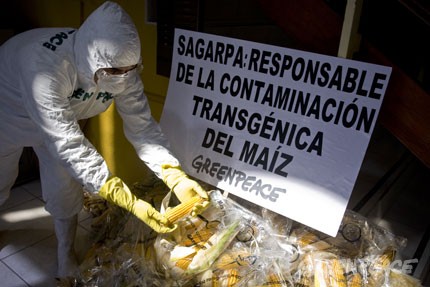 Greenpeach Activists deliver plastic bags of corn with the label: "More evidence? Transgenic corn = contamination." (Photo: Courtesy of Greenpeace Mexico)
Greenpeach Activists deliver plastic bags of corn with the label: "More evidence? Transgenic corn = contamination." (Photo: Courtesy of Greenpeace Mexico)Hector Ortiz Ciscomani, Secretary of Agriculture, Livestock, Water Resources, Fisheries and Aquaculture (SAGARPA) of Sonora, said in 2011 that “it is one of the three states in Mexico, along with Sinaloa and Tamaulipas, which will start planting genetically modified corn in October. This is expected to perhaps double production on the 49,421 hectares in use"[1]. However, the struggle for permit authorization continues.
Carlos Salazar, president of the Mexican National Confederation of Corn Producers (CNPAMM), warned of worsening food security, and said he has decided to support the program for that reason. Meanwhile, the Secretary of SAGARPA at the presidential cabinet level informed the Federal Regulatory Improvement Commission (COFEMER), that the biotechnology could be used in 26 irrigation districts, which cover just under 5.2 million acres in Sinaloa, Sonora, Tamaulipas, Chihuahua, Comarca Lagunera, Nuevo Leon, Baja California and Baja California Sur [2].
The technical justification made by both SAGARPA and SEMARNAT (The Environmental and Natural Resources Secretariat) said that: "This type of corn can be planted in any area not classified as a center of origin [of corn]." The approach still needs to be reviewed.
Currently in Mexico, genetically modified corn containing endotoxins from the bacterium Bacillus thuringiensis (Bt), is planted in several experimental fields. These endotoxins are used to control pests of many crops. A great reduction in the use of chemical pesticides has been achieved and along with this, a reduction in food toxicity from the pesticides.
This is one of the benefits of genetically modified, or genetically engineered, organisms, but the risks should not be ignored.
Sonora Sets its Sights on Production of
Genetically Modified Corn
 Greenpeach Activists deliver plastic bags of corn with the label: "More evidence? Transgenic corn = contamination." (Photo: Courtesy of Greenpeace Mexico)
Greenpeach Activists deliver plastic bags of corn with the label: "More evidence? Transgenic corn = contamination." (Photo: Courtesy of Greenpeace Mexico)